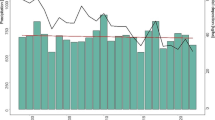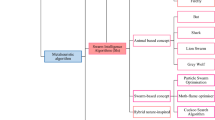Abstract
The modernization processes of hydraulic infrastructures from old open channels to pressurized networks have increased water use efficiency along with a dramatic increase of energy consumptions. The significant energy requirements associated with the increment of the energy tariffs for irrigation involve higher production costs for farmers. Therefore, strategies to reduce energy consumption in irrigation districts are strongly demanded. Methodologies based on sectoring and critical points control have been applied to branched networks with a single water supply point, obtaining significant energy savings. In this work, a new critical point control methodology for networks with multiple sources has been developed: the WEPCM algorithm, which uses the NSGA-II multi-objective evolutionary algorithm to find the lowest energy consumption operation rule of a set of pumping stations connected to an irrigation network that satisfies the pressure requirements, when the critical points are successively disabled. WECPM has been applied to a real irrigation district in Southern Spain. The obtained results were compared with those achieved by the WEBSOM algorithm, developed for sectoring multiple source networks. The control of critical points by the replacement of two pipes and the installation of four booster pumps provided annual energy savings of 36 % compared to the current network operation. Moreover, the control of critical points was more effective than sectoring, obtaining an additional annual energy saving of 10 %.





Similar content being viewed by others
Abbreviations
- γ:
-
Water specific weight
- η:
-
Global efficiency of pumps
- EC (ECnorm):
-
Energy consumption (normalized term of EC)
- CMPD (CMPDnorm):
-
Penalty factor depending on the magnitude of pressure (normalized term of CMPD)
- h ∗j :
-
Hydraulic dimensionless coordinate
- Hi :
-
Pressure head of pumping station i
- Hw-j :
-
Required weighted pressure head when hydrant j operates
- Hw-mch :
-
Required weighted pressure head when the most critical hydrant operates
- i:
-
Pumping stations index
- j:
-
Hydrant index
- l ∗j :
-
Topological dimensionless coordinate related to friction losses in pipes
- lj-i :
-
Distance between the hydrant j and the pumping station i
- lmax-i :
-
Distance between the furthest hydrant and the pumping station i
- nv :
-
Number of decision variables
- N:
-
Number of pumping stations
- Pf:
-
Pressure failure percentage
- Qi :
-
Pumped flow by pumping station i
- trs :
-
Daily irrigation time required during month s
- z ∗j :
-
Topological dimensionless coordinate related to the hydrant elevation j
- zi :
-
Pumping station elevation i
- zj :
-
Hydrant elevation j
References
Abadia R, Rocamora C, Ruiz-Canales A, Puerto H (2008) Energy efficiency in irrigation distribution networks I: theory. Biosyst Eng 101(1):21–27
Allen RG, Pereira LS, Raes D, Smith M (1998) Crop evapotranspiration: guidelines for computing crop water requirements. Irrigation and drainage paper no. 56. Food and Agricultural Organization of the United Nations (FAO), Rome
Brazilian et al (2011) Considering the energy, water and food nexus: towards an integrated modelling approach. Energy Policy 39:7896–7906
Carrillo Cobo MT, Rodríguez Díaz JA, Montesinos P, López Luque R, Camacho Poyato E (2011) Low energy consumption seasonal calendar for sectoring operation in pressurized irrigation networks. Irrig Sci 29:157–169
Chandapillai J, Sudheer KP, Saseendran S (2012) Design of water distribution network for equitable supply. Water Resour Manag 26:391–406
Corominas J (2010) Agua y energía en el riego en la época de la sostenibilidad. Ingeniería del Agua 17(3):219–233
Deb K, Pratap A, Agarwal S, Meyarivan T (2002) A fast elitist multiobjective genetic algorithm: NSGA-II. IEEE Trans Evol Comput 6(2):182–197
Dijkstra EW (1959) A note on two problems in connexion with graphs. Numer Math 1:269–271
Fernández García I, Rodríguez Díaz JA, Camacho Poyato E, Montesinos P (2013) Optimal operation of pressurized irrigation networks with several supply sources. Water Resour Manag 27:2855–2869
Goldberg DE (1989) Genetic algorithms in search, optimization and machine learning. Addison-Wesley Longman Publishing Co, Incl, Boston
Hardy L, Garrido A, Juana L (2012) Evaluation of Spain’s water-energy nexus. Water Resour Dev 28(1):151–170
Jackson TM, Khan S, Hafeez M (2010) A comparativeanalysis of water application and energy consumption at theirrigated field level. Agric Water Manag 97:1477–1485
Jamieson DG, Shamir U, Martinez F, Franchini M (2007) Conceptual design of a generic, real-time, near-optimal control system for water distribution networks. J Hydroinf 9(1):3–14
Jiménez Bello MA, Martínez Alzamora F, Bou Soler V, Bartolí Ayala HJ (2010) Methodology for grouping intakes of pressurised irrigation networks into sectors to minimise energy consumption. Biosyst Eng 105:429–438
Khadra R, Lamaddalena N (2010) Development of a decission support system for irrigation systems analysis. Water Resour Manag 24:3279–3297
Lamaddalena N, Khila S (2012) Energy saving with variable speed pumps in on-demand irrigation systems. Irrig Sci 30:157–166
Lecina S, Isidoro D, Playán E, Aragüés R (2010) Irrigation modernization and water conservation in Spain: the case of Riegos del Alto Aragón. Agric Water Manag 97:1663–1675
Montesinos P, García-Guzmán A, Ayuso JL (1999) Water distribution network optimization using a modified genetic algorithm. Water Resour Res 35:3467–3473
Moradi-Jalal M, Rodin SI, Mariño MA (2004) Use of genetic algorithm in optimization of irrigation pumping stations. J Irrig Drain Eng 130(5):357–365
Moreno MA, Planells P, Córcoles JL, Tarjuelo JM, Carrión PA (2009) Development of a new methodology to obtain the characteristic pump curves that minimize the total costs at pumping stations. Biosyst Eng 102:95–105
Pérez Urrestarazu L, Rodríguez Díaz JA, Camacho Poyato E, López Luque R (2009) Quality of service in irrigation distribution networks: case of Palos de la Frontera irrigation district (Spain). J Irrig Drain Eng 135(6):755–762
Playán E, Mateos L (2006) Modernization and optimization of irrigation systems to increase water productivity. Agric Water Manag 80:100–116
Pratap R (2010) Getting started with Matlab. A quick introduction for scientist and engineers. Oxford University Press, USA
Rocamora MC, Abadía R, Ruiz A (2008) Ahorro y Eficiencia energética en las Comunidades de Regantes. Ministerio de Industria, Turismo y Comercio, IDAE, Madrid
Rodríguez Díaz JA, Camacho Poyato E, Blanco Pérez M (2011) Evaluation of water and energy use in pressurized irrigation networks in Southern Spain. J Irrig Drain Eng 137(10):644–650
Rodríguez Díaz JA, Pérez Urrestarazu L, Camacho Poyato E, Montesinos P (2012a) Modernizing water distribution networks. Lessons from the Bembézar MD irrigation district, Spain. Outlook Agric 41(4):229–236
Rodríguez Díaz JA, Montesinos P, Camacho Poyato E (2012b) Detecting critical points in on-demand irrigation pressurized networks - a new methodology. Water Resour Manag 26(6):1693–1713
Rossman LA (2000) EPANET 2. Users manual. US Environmental Protection Agency (EPA), USA
Savic D (2007) Single-objective vs. multio-objective optimization for integrated decision support. Proceedings of the first biennial meeting of the international environmental modeling and software society 1:7–12 Lugano, Switzerland, June 24–27
Siew C, Tanyimboh T (2012) Penalty-free feasibility boundary convergent multi-objective evolutionary algorithm for the optimization of water distribution systems. Water Resour Manag 26:4485–4507
van Dijk M, van Vuuren SJ, van Zyl JE (2008) Optimising water distribution systems using a weighted penalty in a genetic algorithm. Water SA (Online) 34(5):537–548
Acknowledgments
This research is part of the AMERE project (AGL2011-30328-C02-02), funded by the Spanish Ministry of Economy and Competitiveness.
Author information
Authors and Affiliations
Corresponding author
Rights and permissions
About this article
Cite this article
García, I.F., Montesinos, P., Poyato, E.C. et al. Methodology for Detecting Critical Points in Pressurized Irrigation Networks with Multiple Water Supply Points. Water Resour Manage 28, 1095–1109 (2014). https://doi.org/10.1007/s11269-014-0538-x
Received:
Accepted:
Published:
Issue Date:
DOI: https://doi.org/10.1007/s11269-014-0538-x




